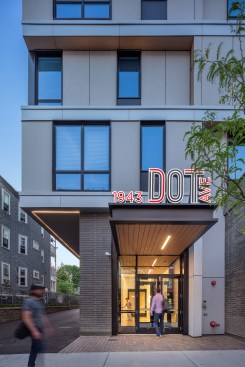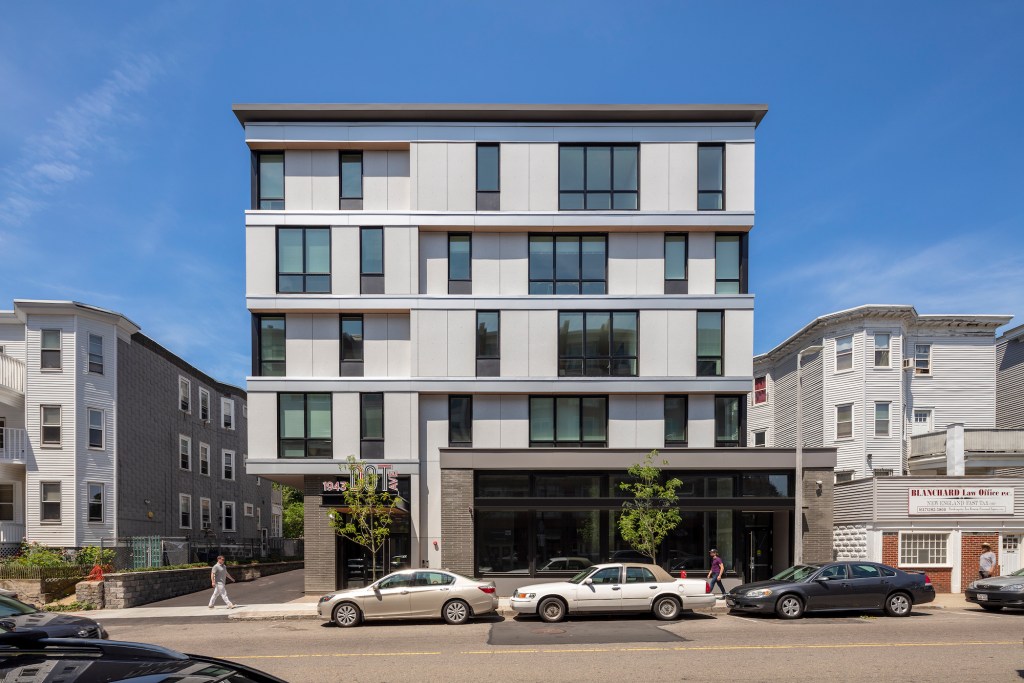While Boston is undergoing an extreme building boom, with an influx of luxury housing, ThoughtCraft Architects and real estate firm Peregrine Group set out to create a transit-oriented, workforce housing development in Dorchester.
One of the challenges in developing workforce housing, especially during a building boom, is navigating the skyrocketing cost to acquire land, says Chris Johns, founding partner of ThoughtCraft Architects.
“What we’re trying to do is convince developers to build smaller units. Density is economically and environmentally beneficial,” he says. “The smaller the unit, the higher the rent per square foot. Build the same building, but squeeze in a few more units; this creates more affordability. And if you can build near public transportation, the parking demand can be reduced. That’s a way you can make workforce housing feasible.”
The partners did just that. When the developer approached ThoughtCraft Architects about its 1943 Dot Ave project, it had wanted 45 to 55 units. But with smaller units and a number of studio apartments, the team was able to achieve 64 units on an infill site next to public transit. “It doesn’t have to have high-end finishes and monster units,” Johns says. “If you’re building smart, nicely planned, functional units with a decent amount of storage and maximized natural light in a good location, I feel like that’s the key.”
The architect also explored alternative construction options to save the developer time as well as boost the building’s energy performance.
The architect had been looking at structural insulated panels, or SIPs, for a long time but hadn’t seen them utilized in the Boston market previously at this scale. SIPs consist of an insulating foam core sandwiched between two structural facings, typically oriented strand board, and are manufactured under factory-controlled conditions.

John Horner Photography
1943 Dot Ave is designed to bridge the scale and proportion of the neighborhood's existing three-story apartment buildings, known as triple-deckers, and the newly constructed larger-scale multifamily developments.
For 1943 Dot Ave, ThoughtCraft Architects created a four-story wood-framed apartment community over a concrete podium and ground-floor commercial space by marrying on-site construction with prefabricated wood stud panels and the SIPs for the envelope. “We should be building better performing buildings. And the SIPs simplified the installation of the entire wall assembly by reducing the required trades in the sequence. The wall shows up with insulation and sheathing, and the requirement for furring and continuous insulation was greatly reduced,” says Johns. “This simplified the installation of the exterior reconstituted stone panels, tightened up the timeline, and provided a well-performing envelope.”
The SIPs also gave the architect flexibility in how it staggered the building’s façade, which is designed to pay tribute to the neighborhood’s architecture history. “By bringing the majority of vertical load-bearing structure to the inside of the building, we were able to cantilever portions of the façade to create offsets in the building’s exterior. This results in a unique aesthetic, which is a bit unexpected in wood-framed multifamily buildings with no structural steel.” The design relates to the scale of the neighborhood’s three-story apartment buildings known as triple-deckers, where each unit is visually expressed by staggering the façade on the outside.
The development also was designed to be LEED certified. In addition to the highly insulated envelope, it includes a high-efficiency electric heating and cooling system, Energy Star appliances, and low-flow water fixtures. The architect also reduced long-term maintenance by utilizing an exterior façade material that doesn’t require painting over time.
“It has a reading like a modular-built building, but that stems from our idea to make every unit legible on the exterior,” he says. “Design does matter, it does add value.”
The project was completed in April 2019, and the developer has already sold the building and made its return on investment. It was acquired by Marcus Partners, a real estate investment, management, and development firm.
“Everything that is being built at this scale and at this price point is not very forward-looking. We set out to try to make something uniquely contemporary and contextual that helps differentiate our client in this market,” Johns adds. “The building grabs people’s attention and makes them more curious about architecture and the thoughts behind it.”
